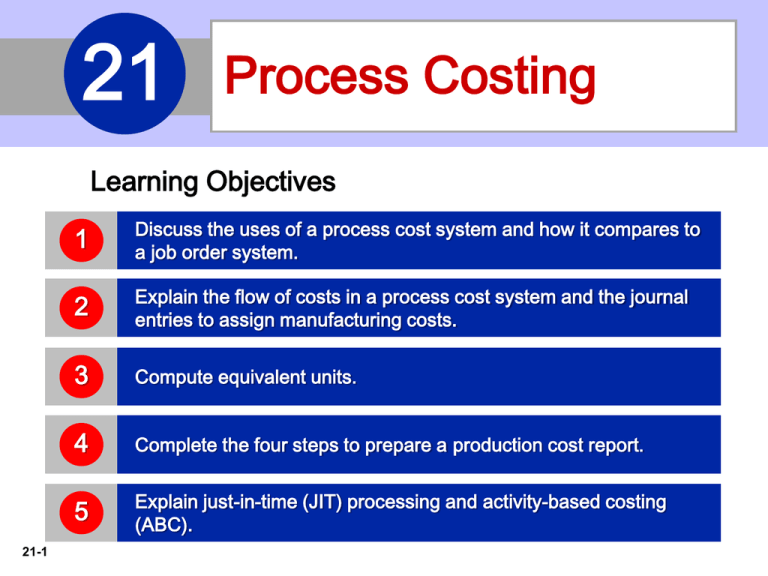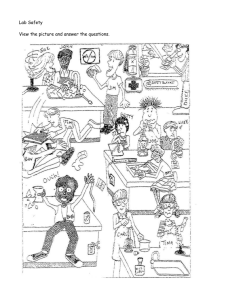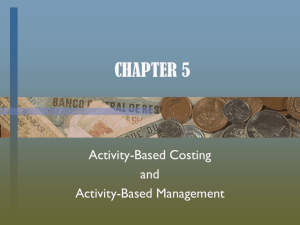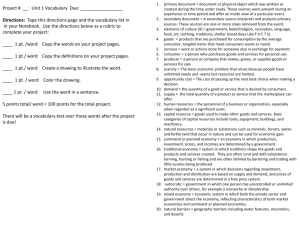
21
Process Costing
Learning Objectives
21-1
1
Discuss the uses of a process cost system and how it compares to
a job order system.
2
Explain the flow of costs in a process cost system and the journal
entries to assign manufacturing costs.
3
Compute equivalent units.
4
Complete the four steps to prepare a production cost report.
5
Explain just-in-time (JIT) processing and activity-based costing
(ABC).
LEARNING
OBJECTIVE
1
Discuss the uses of a process cost system and
how it compares to a job order system.
Uses of Process Cost Systems
Use to apply costs to similar products that are massproduced in a continuous fashion.
Examples include the production of cereal, paint,
manufacturing steel, oil refining and soft drinks.
Illustration 21-1
Manufacturing processes
21-2
LO 1
Use of Process Cost Systems
Examples of companies that primarily use either a process cost
system or a job order cost system.
Illustration 21-2
Process cost and job order cost
companies and products
21-3
LO 1
Use of Process Cost Systems
Question
Which of the following items is not a characteristic of a process
cost system:
a. Once production begins, it continues until the finished
product emerges.
b. The focus is on continually producing homogenous products.
c. When the finished product emerges, all units have precisely
the same amount of materials, labor, and overhead.
d. The products produced are heterogeneous in nature.
21-4
LO 1
Process Cost for Service Companies
Service companies that provide individualized, non-routine
services will probably benefit from using a job order cost
system.
Those that perform routine, repetitive services will probably
be better off with a process cost system.
21-5
LO 1
Similarities and Differences Between Job
Order Cost and Process Cost Systems
Job Order Cost
Costs assigned to each job.
Products have unique
Process Cost
Costs tracked through a
series of connected
manufacturing processes or
departments.
characteristics.
Products are uniform or
relatively homogeneous and
produced in a large volume.
21-6
LO 1
Job Order Cost and Process Cost Flow
Illustration 21-3
Job order cost and
process cost flow
21-7
LO 1
Job Order Cost and Process Cost Flow
SIMILARITIES
DIFFERENCES
1. Manufacturing cost
elements.
1. Number of work in
process accounts used.
2. Accumulation of the
costs of materials,
labor, and overhead.
2. Documents used to track
costs.
3. Flow of costs.
3. Point at which costs are
totaled.
4. Unit cost computations.
21-8
LO 1
Job Order Cost and Process Cost Flow
Illustration 21-4
Job order versus process
cost systems
21-9
LO 1
Use of Process Cost Systems
Question
Indicate which of the following statements is not correct:
a. Both a job order and a process cost system track the same
three manufacturing cost elements – direct materials, direct
labor, and manufacturing overhead.
b. In a job order cost system, only one work in process account
is used, whereas in a process cost system, multiple work in
process accounts are used.
c. Manufacturing costs are accumulated the same way in a job
order and in a process cost system.
d. Manufacturing costs are assigned the same way in a job order
and in a process cost system.
21-10
LO 1
DO IT! 1
Compare Job Order and Process Cost
Systems.
Indicate whether the following statements are true or false.
False
True
False
1. A law firm is likely to use process costing for major
lawsuits.
2. A manufacturer of paintballs is likely to use process
costing.
3. Both job order and process costing determine product
costs at the end of a period of time, rather than when
a product is completed.
False
21-11
4. Process costing does not keep track of manufacturing
overhead.
LO 1
LEARNING
OBJECTIVE
2
Explain the flow of costs in a process cost system and the
journal entries to assign manufacturing costs.
Process Cost Flow
Tyler Company manufactures roller blade and skateboard wheels
that it sells to manufactures and retail outlets. Manufacturing
consists of two processes: machining and assembly. The Machining
Department shapes, hones, and drills the raw materials. The
Assembly Department assembles and packages the parts.
21-12
Illustration 21-5
Flow of costs in process cost system
LO 2
Assigning Manufacturing Costs
Accumulation of the cost of materials, labor, and overhead
is the same as in job order costing.
►
Debit Raw Materials Inventory for purchases of raw
materials.
►
Debit Factory Labor for factory labor incurred.
►
Debit Manufacturing Overhead for overhead cost
incurred.
Assignment of the three manufacturing cost elements to
Work in Process in a process cost system is different from
a job order cost system.
21-13
LO 2
Assigning Manufacturing Costs
MATERIAL COSTS
A process cost system requires fewer material requisition
slips than a job order cost system.
Materials are used for processes and not specific jobs.
Requisitions are for larger quantities of materials.
Journal entry to record materials used:
Work in Process—Machining
XXXXX
Work in Process—Assembly
XXXXX
Raw Materials Inventory
21-14
XXXXX
LO 2
Assigning Manufacturing Costs
FACTORY LABOR COSTS
Time tickets may be used in both systems.
All labor costs incurred within a production department are a
cost of processing.
The journal entry to record factory labor costs:
Work in Process—Machining
XXXXX
Work in Process—Assembly
XXXXX
Factory Labor
21-15
XXXXX
LO 2
Assigning Manufacturing Costs
MANUFACTURING OVERHEAD COSTS
Objective of assigning overhead is to allocate overhead to
production departments on objective and equitable basis.
Use the activity that “drives” or causes the costs.
Machine time used is a primary driver.
Journal entry to allocate overhead:
Work in Process—Machining
XXXXX
Work in Process—Assembly
XXXXX
Manufacturing Overhead
21-16
XXXXX
LO 2
Management Insight
Caterpillar
Choosing a Cost Driver
In one of its automated cost centers, Caterpillar feeds work into the
cost center, where robotic machines process it and transfer the
finished job to the next cost center without human intervention. One
person tends all of the machines and spends more time maintaining
machines than operating them. In such cases, overhead rates based
on direct labor hours may be misleading. Surprisingly, some
companies continue to assign manufacturing overhead on the basis
of direct labor despite the fact that there is no cause-and-effect
relationship between labor and overhead.
21-17
LO 2
Assigning Manufacturing Costs
TRANSFERS
Monthly Entry to transfer goods to next department:
Work in Process—Assembly
XXXXX
Work in Process—Machining
XXXXX
Entry to transfer completed goods to Finished Goods:
Finished Goods Inventory
XXXXX
Work in Process—Assembly
XXXXX
Entry to record Cost of Goods sold at the time of sale:
Cost of Goods Sold
Finished Goods Inventory
21-18
XXXXX
XXXXX
LO 2
Assigning Manufacturing Costs
Question
In making the journal entry to assign raw materials
costs:
a. The debit is to Finished goods Inventory.
b. The debit is often to two or more work in process
accounts.
c. The credit is generally to two or more work in
process accounts.
d. The credit is to Finished Goods Inventory.
21-19
LO 2
DO IT! 2
Manufacturing Costs in Process
Costing
Blue Diamond Company manufactures ZEBO through two
processes: blending and bottling. In June, raw materials used
were Blending $18,000 and Bottling $4,000. Factory labor costs
were Blending $12,000 and Bottling $5,000. Manufacturing
overhead costs were Blending $6,000 and Bottling $2,500. The
company transfers units completed at a cost of $19,000 in the
Blending Department to the Bottling Department. The Bottling
Department transfers units completed at a cost of $11,000 to
Finished Goods. Journalize the assignment of these costs to
the two processes and the transfer of units as appropriate.
21-20
LO 2
DO IT! 2
Manufacturing Costs in Process
Costing
Journalize the assignment of these costs to the two processes.
To Record Materials Used:
Work in Process—Blending
18,000
Work in Process—Bottling
4,000
Raw Materials Inventory
22,000
To Assign Factory Labor to Production:
Work in Process—Blending
12,000
Work in Process—Bottling
5,000
Factory Labor
21-21
17,000
LO 2
DO IT! 2
Manufacturing Costs in Process
Costing
Journalize the assignment of these costs to the two processes.
To Assign Overhead to Production:
Work in Process—Blending
6,000
Work in Process—Bottling
2,500
Manufacturing Overhead
21-22
8,500
LO 2
DO IT! 2
Manufacturing Costs in Process
Costing
Journalize the transfer of units as appropriate.
To Record Transfer of Units to the Bottling Department:
Work in Process—Bottling
19,000
Work in Process—Blending
19,000
To Record Transfer of Units to Finished Goods:
Finished Goods Inventory
Work in Process—Bottling
21-23
11,000
11,000
LO 2
LEARNING
OBJECTIVE
3
Compute equivalent units.
Illustration: Suppose you have a work-study job in the office of
your college’s president, and she asks you to compute the cost
of instruction per full-time equivalent student at your college.
The college’s vice president for finance provides the following
information.
Costs:
Total cost of instruction
Illustration 21-6
Information for full-time
student example
$9,000,000
Student population:
21-24
Full-time students
900
Part-time students
1,000
LO 3
Compute Equivalent Units
Illustration: Part-time students take 60% of the classes of a fulltime student during the year. To compute the number of fulltime equivalent students per year, you would make the
following computation.
Illustration 21-7
Full-time equivalent unit computation
Cost of instruction per full-time equivalent student =
21-25
Total cost of instruction
$9,000,000
Number of full-time equivalent students
÷
$
1,500
6,000
LO 3
Weighted-Average Method
Considers the degree of completion (weighting) of
units completed and transferred out and units in
ending work in process.
Most widely used method.
Beginning work in process not part of computation of
equivalent units.
Illustration 21-8
Equivalent units of production
formula
21-26
LO 3
Weighted-Average Method
Illustration: The output of Kori Company’s Packaging
Department during the period consists of 10,000 units
completed and transferred out, and 5,000 units in ending work
in process which are 70% completed.
Calculate the equivalent units of production.
Completed units
Work in process equivalent units (5,000 x 70%)
10,000
3,500
13,500
21-27
LO 3
Refinements on the Weighted-Average
Method
Illustration: Kellogg Company has produced Eggo® Waffles
since 1970. Three departments produce these waffles: Mixing,
Baking, and Freezing/Packaging. The Mixing Department
combines dry ingredients, including flour, salt, and baking
powder, with liquid ingredients, including eggs and vegetable
oil, to make waffle batter.
Illustration 21-9 provides information related to the Mixing
Department at the end of June.
21-28
LO 3
Refinements on Weighted-Average
Illustration: Information related to the Mixing Department at
the end of June.
Illustration 21-9
Information for Mixing
Department
21-29
LO 3
Refinements on Weighted-Average
Conversion costs are labor costs plus
Illustration 21-10
Computation of equivalent
units—Mixing Department
overhead costs.
Beginning work in process is not part of the
equivalent-units-of-production formula.
21-30
LO 3
Refinements on Weighted-Average
Illustration 21-11
Refined equivalent units of
production formula
21-31
LO 3
Compute Equivalent Units
Question
The Mixing Department’s output during the period consists of
20,000 units completed and transferred out, and 5,000 units in
ending work in process 60% complete as to materials and
conversions costs. Beginning inventory is 1,000 units, 40%
complete as to materials and conversion costs. The equivalent
units of production are:
21-32
a.
22,600
b.
23,000
c.
24,000
d.
25,000
LO 3
People, Planet, and Profit Insight
Haven’t I Seen That Before?
For a variety of reasons, many companies, including General Electric, are
making a big push to remanufacture goods that have been thrown away. Items
getting a second chance include cell phones, computers, home appliances, car
parts, vacuum cleaners, and medical equipment. Businesses have figured out
that profit margins on remanufactured goods are significantly higher than on
new goods. As commodity prices such as copper and steel increase, reusing
parts makes more sense. Also, as more local governments initiate laws
requiring that electronic sand appliances be recycled rather than thrown away,
the cost of remanufacturing declines because the gathering of used goods
becomes far more efficient. Besides benefitting the manufacturer,
remanufacturing provides goods at a much lower price to consumers, reduces
waste going to landfills, saves energy, reuses scarce resources, and reduces
emissions. For example, it was estimated that a remanufactured car starter
results in about 50% less carbon dioxide emissions than making a new one.
Source: James R. Hagerty and Paul Glader, “From Trash Heap to Store Shelf,” Wall
Street Journal Online (January 24, 2011).
21-33
LO 3
DO IT! 3
Equivalent Units
The fabricating department Outdoor Essentials has the
following production and cost data for the current month.
Beginning
Work in Process
–0–
Units
Transferred Out
15,000
Ending
Work in Process
10,000
Materials are entered at the beginning of the process. The
ending work in process units are 30% complete as to conversion
costs. Compute the equivalent units of production for (a)
materials and (b) conversion costs.
21-34
LO 3
DO IT! 3
Equivalent Units
The fabricating department has the following production and
cost data for the current month.
Beginning
Work in Process
–0–
Units
Transferred Out
15,000
Ending
Work in Process
10,000
Compute the equivalent units of production for (a) materials and
(b) conversion costs.
21-35
Units transferred out
15,000
Ending work in process units
10,000
25,000
LO 3
DO IT! 3
Equivalent Units
The fabricating department has the following production and
cost data for the current month.
Beginning
Work in Process
–0–
Units
Transferred Out
15,000
Ending
Work in Process
10,000
Compute the equivalent units of production for (a) materials and
(b) conversion costs.
21-36
Units transferred out
15,000
Equivalent unit in ending WIP (10,000 x 30%)
3,000
18,000
LO 3
LEARNING
OBJECTIVE
4
Complete the four steps to prepare a
production cost report.
A production cost report is the
Key document used to understand activities.
Prepared for each department and shows Production
Quantity and Cost data.
Four steps in preparation:
Step 1: Compute physical unit flow
Step 2: Compute equivalent units of production
Step 3: Compute unit production costs
Step 4: Prepare a cost reconciliation schedule
21-37
LO 4
Production Cost Report
Flow of costs to make an Eggo® Waffle and the related
production cost reports for each department.
Illustration 21-12
Flow of costs in making
Eggo® Waffles
21-38
LO 4
21-39
Illustration 21-13
Unit and cost data—Mixing Department
LO 4
Production Cost Report
Compute the Physical Unit Flow (Step 1)
21-40
Physical units - actual units to be accounted for during
a period, regardless of work performed.
Total units to be accounted for - units started (or
transferred) into production during the period + units in
production at beginning of period.
Total units accounted for - units transferred out during
period + units in process at end of period.
LO 4
Production Cost Report
Compute the Physical Unit Flow (Step 1)
Illustration 21-14
Physical unit flow—Mixing Department
21-41
LO 4
Production Cost Report
Compute Equivalent Units of Production (Step 2)
Mixing Department
Department adds materials at beginning of process and
Incurs conversion costs uniformly during the process.
Illustration 21-15
Computation of equivalent units—Mixing Department
21-42
LO 4
Production Cost Report
Compute Unit Production Costs (Step 3)
Costs expressed in terms of equivalent units of
production.
When equivalent units of production are different for
materials and for conversion costs, three unit costs are
computed:
1. Materials
2. Conversion
3. Total Manufacturing
21-43
LO 4
Production Cost Report
Compute Unit Production Costs (Step 3)
Compute total materials cost related to Eggo® Waffles:
Work in process, June 1
Direct materials costs
Illustration 21-16
$ 50,000
Cost added to production during June
Direct material cost
Total material costs
400,000
$450,000
Illustration 21-17
21-44
LO 4
Production Cost Report
Compute Unit Production Costs (Step 3)
Compute total materials cost related to Eggo® Waffles:
Work in process, June 1
Conversion costs
Illustration 21-18
$ 35,000
Costs added to production during June
Conversion costs
Total conversion costs
170,000
$205,000
Illustration 21-19
21-45
LO 4
Production Cost Report
Compute Unit Production Costs (Step 3)
Illustration 21-19
Compute total manufacturing costs per unit:
21-46
Illustration 21-20
LO 4
Production Cost Report
Prepare a Cost Reconciliation Schedule (Step 4)
Kellogg charged total costs of $655,000 to the Mixing
Department in June, calculated as follows.
Costs to be accounted for
Work in process, June 1
Started into production
Total costs
21-47
Illustration 21-21
$ 85,000
570,000
$655,000
LO 4
Production Cost Report
Prepare a Cost Reconciliation Schedule (Step 4)
Illustration 21-22
Cost reconciliation schedule—
Mixing Department
21-48
LO 4
Prepare the
Production
Cost
Report
Illustration 21-23
Production cost report
21-49
Production Cost Report
Question
Largo Company has unit costs of $10 for materials and $30 for
conversion costs. If there are 2,500 units in ending work in
process, 40% complete as to conversion costs and fully
complete as to materials cost, the total cost assignable to the
ending work in process inventory is:
21-50
a.
$45,000.
b.
$55,000.
c.
$75,000.
d.
$100,000.
LO 4
Production Cost Report
Costing Systems—Final Comments
Companies often use a combination of a process cost
and a job order cost system.
Called operations costing, this hybrid system is similar
to process costing in its assumption that standardized
methods are used to manufacture the product.
At the same time, the product may have some
customized, individual features that require the use of
a job order cost system.
21-51
LO 4
DO IT! 4
Cost Reconciliation Schedule
In March, Rodayo Manufacturing had the following unit production
costs: materials $6 and conversion costs $9. On March 1, it had zero
work in process. During March, Rodayo transferred out 12,000 units.
As of March 31, 800 units that were 25% complete as to conversion
costs and 100% complete as to materials were in ending work in
process. Assign the costs to the units transferred out and in process.
Costs transferred out (12,000 x $15)
Work in process, March 31
Materials (800 x $6)
Conversion costs (200* x $9)
Total costs
*800 x 25%
21-52
$180,000
$4,800
1,800
6,600
$186,600
LO 4
LEARNING
OBJECTIVE
5
Explain just-in-time (JIT) processing and
activity-based costing (ABC).
Just-In-Time Processing
A processing system that is dedicated to having the right products
or parts as they are needed.
21-53
Objective: To eliminate all manufacturing inventories to make
funds and space available for more productive purposes.
Elements of JIT: Dependable suppliers; multi-skilled workforce;
total quality control system.
Benefits of JIT: Significant reduction or elimination of
manufacturing inventories; enhanced product quality; reduced
rework and storage costs; savings from improved flow of goods.
LO 5
Just-in-Time Processing
21-54
Illustration 21-24
Just-in-time processing
LO 5
Activity-Based Costing
An overhead cost allocation system that focuses on activities
performed in producing a product.
21-55
ABC System: More that one basis of allocating activity
costs to products is needed.
Assumptions of ABC: All overhead costs related to the
activity
►
must be driven by the cost driver used to assign costs to
products.
►
should respond proportionally to changes in the activity
level of the cost driver.
LO 5
Activity-Based Costing
Illustration 21-25
Activities and cost
drivers in ABC
21-56
LO 5
Management Insight
ABC Evaluated
Surveys of companies often show ABC usage of approximately 50%. Yet, in
recent years, articles about ABC have expressed mixed opinions regarding its
usefulness. To evaluate ABC practices and user satisfaction with ABC, a survey
was conducted of 348 companies worldwide. Some of the interesting findings
included the following: ABC methods are widely used across the entire value
chain, rather than being primarily used to allocate production-specific costs; only
25% of non-ABC companies think they are accurately tracing the costs of
activities, while 70% of ABC companies think their company does this well; and
respondents felt that ABC provides greater support for financial, operational,
and strategic decisions. More than 87% of respondents said that their ideal
costing system would include some form of ABC. Since this significantly
exceeds the 50% of the respondents actually using it, ABC usage may well
increase in the future.
Source: William Stratton, Denis Desroches, Raef Lawson, and Toby Hatch, “ActivityBased Costing: Is It Still Relevant?” Management Accounting Quarterly (Spring, 2009),
pp. 31–39.
21-57
LO 5
DO IT! 5
JIT and ABC
Indicate whether the following statements are true or false.
False
1. Continuous process manufacturing often results in a
False
2. Companies that use just-in-time processing complete
reduction of inventory.
and store finished goods all the time to meet rush
orders from customers.
True
3. A major benefit of just-in-time processing is production
cost savings from the improved flow of goods through
the processes.
21-58
LO 5
DO IT! 5
JIT and ABC
Indicate whether the following statements are true or false.
False
4. An ABC system is similar to traditional costing
systems in accounting for manufacturing costs but
differs in regard to period costs.
True
5. The primary benefit of ABC is more accurate and
False
6. In recent years, the amount of direct labor used in
meaningful costs.
many industries has greatly increased and total
overhead costs have significantly decreased.
21-59
LO 5
LEARNING
OBJECTIVE
6
APPENDIX 21A: Apply activity-based
costing to a manufacturer.
Activity-Based Costing
Involves the following four steps.
1. Identify and classify the activities involved in the manufacture
of specific products and assign overhead to cost pools.
2. Identify the cost driver that has a strong correlation to the
costs accumulated in each cost pool.
3. Compute the activity-based overhead rate for each cost pool.
4. Allocate overhead costs to products, using the overhead
rates determined for each cost pool.
21-60
LO 6
Identify and Classify Activities and Allocate
Overhead to Cost Pools (Step 1)
Overhead costs are assigned directly to the appropriate activity
cost pool.
Illustration 21A-2
Activity cost pools and
estimated overhead
21-61
LO 6
Identify Cost Drivers (Step 2)
Cost driver must accurately measure the actual consumption
of the activity by the various products.
Illustration 21A-3: Cost drivers that Atlas Company identifies
and their total expected use per activity cost pool.
Illustration 21A-3
Cost drivers and their
expected use
21-62
LO 6
Compute Activity-Based Overhead Rates
(Step 3)
Next, the company computes an activity-based overhead rate
per cost driver.
Illustration 21A-4
Illustration 21A-5
21-63
LO 6
Allocate Overhead Costs to Products (Step
4)
In allocating overhead costs, it is necessary to know the
expected use of cost drivers for each product. Because of its
low volume and higher number of components, the Ab Coaster
requires more setups and purchase orders than the Ab Bench.
Illustration 21A-6
Expected use of cost
drivers per product
21-64
LO 6
Allocate Overhead Costs to Products
To allocate overhead costs, Atlas multiplies the activity-based
overhead rates per cost driver (Ill. 21A-5) by the number of
cost drivers expected to be used per product (Ill. 21A-6).
Illustration 21A-7
Allocation of activity
cost pools to
products
21-65
LO 6
Allocate Overhead Costs to Products
To allocate overhead costs, Atlas multiplies the activity-based
overhead rates per cost driver (Ill. 21A-5) by the number of
cost drivers expected to be used per product (Ill. 21A-6).
21-66
Illustration 21A-7
LO 6
Comparing Unit Costs
Illustration 17-10
Likely consequence of differences in assigning overhead.
21-67
Overpricing the Ab Bench and possibly losing market
share to competitors.
Sacrificing profitability by underpricing the Ab Coaster.
Illustration 21A-8
Comparison of unit
product costs
LO 6
Benefits and Limitations of ABC
Benefits
1. More cost pools, therefore more accurate product costing.
2. Enhanced control over overhead costs.
3. Better management decisions.
Limitations
1. Expensive to use.
2. Some arbitrary allocations remain.
21-68
LO 6
Copyright
Copyright © 2015 John Wiley & Sons, Inc. All rights reserved.
Reproduction or translation of this work beyond that permitted in
Section 117 of the 1976 United States Copyright Act without the
express written permission of the copyright owner is unlawful.
Request for further information should be addressed to the
Permissions Department, John Wiley & Sons, Inc. The purchaser
may make back-up copies for his/her own use only and not for
distribution or resale. The Publisher assumes no responsibility for
errors, omissions, or damages, caused by the use of these
programs or from the use of the information contained herein.
21-69





